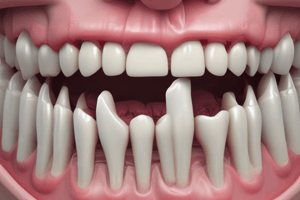Podcast
Questions and Answers
What is the primary function of dentine in teeth?
What is the primary function of dentine in teeth?
- To enhance the aesthetic appearance of teeth
- To produce saliva for digestion
- To facilitate the movement of the jaw
- To provide structural support and protect the pulp (correct)
Which type of dentine is formed in response to dental caries?
Which type of dentine is formed in response to dental caries?
- Secondary dentine
- Tertiary dentine (correct)
- Primary dentine
- Enamel dentine
What embryonic origin do dentine-forming cells derive from?
What embryonic origin do dentine-forming cells derive from?
- Ectoderm cells
- Endoderm cells
- Neural crest cells (correct)
- Mesoderm cells
Which tissue is considered the bulk of the tooth?
Which tissue is considered the bulk of the tooth?
How is secondary dentine different from primary dentine?
How is secondary dentine different from primary dentine?
What is the clinical significance of understanding dentine structure?
What is the clinical significance of understanding dentine structure?
Which type of dentine is characterized by its irregular formation and response to stimuli?
Which type of dentine is characterized by its irregular formation and response to stimuli?
What role does dentine play in the management of dental hypersensitivity?
What role does dentine play in the management of dental hypersensitivity?
What distinguishes tertiary dentine from other types of dentine?
What distinguishes tertiary dentine from other types of dentine?
Which of the following is NOT a type of dentine?
Which of the following is NOT a type of dentine?
Flashcards
Function of Dentine
Function of Dentine
Provides structural support and protects the pulp.
What is Tertiary Dentine?
What is Tertiary Dentine?
Formed in response to external factors, like dental caries.
Origin of Dentine Forming Cells
Origin of Dentine Forming Cells
Neural crest cells.
Bulk of the Tooth
Bulk of the Tooth
Signup and view all the flashcards
Secondary Dentine
Secondary Dentine
Signup and view all the flashcards
Understanding Dentine Structure
Understanding Dentine Structure
Signup and view all the flashcards
Tertiary Dentine Characteristics
Tertiary Dentine Characteristics
Signup and view all the flashcards
Dentine & Hypersensitivity
Dentine & Hypersensitivity
Signup and view all the flashcards
Tertiary Dentine Formation
Tertiary Dentine Formation
Signup and view all the flashcards
Not a Type of Dentine
Not a Type of Dentine
Signup and view all the flashcards
Study Notes
Dentine Structure and Composition
- Dentine is the primary component of a tooth, located beneath enamel and surrounding the pulp.
- Dentinogenesis is the formation of dentine, a process involving odontoblasts.
- Odontoblasts are derived from ectomesenchyme cells, which in turn originate from neural crest cells.
- The structure of dentine plays a crucial role in its function, influencing sensitivity, adhesion potential, and resilience to decay and damage.
- Understanding dentine's properties is vital in dental diagnostics, treatment planning, and patient management.
Types of Dentine
- Primary Dentine is formed during tooth development and accounts for the main bulk of the tooth.
- Secondary Dentine is produced after tooth eruption, slowly adding to the dentine throughout life.
- Tertiary Dentine forms as a response to injury or irritation of the pulp, acting as a protective barrier.
Clinical Significance of Dentine
- Knowledge of dentine aids in identifying dental caries, assessing tooth sensitivity, and interpreting radiographic images.
- It guides the choice of restorative materials, bonding techniques, and treatment options.
- Understanding the relationship between dentine and pulp health is critical in managing dental pathologies and facilitating pulp repair.
Studying That Suits You
Use AI to generate personalized quizzes and flashcards to suit your learning preferences.




